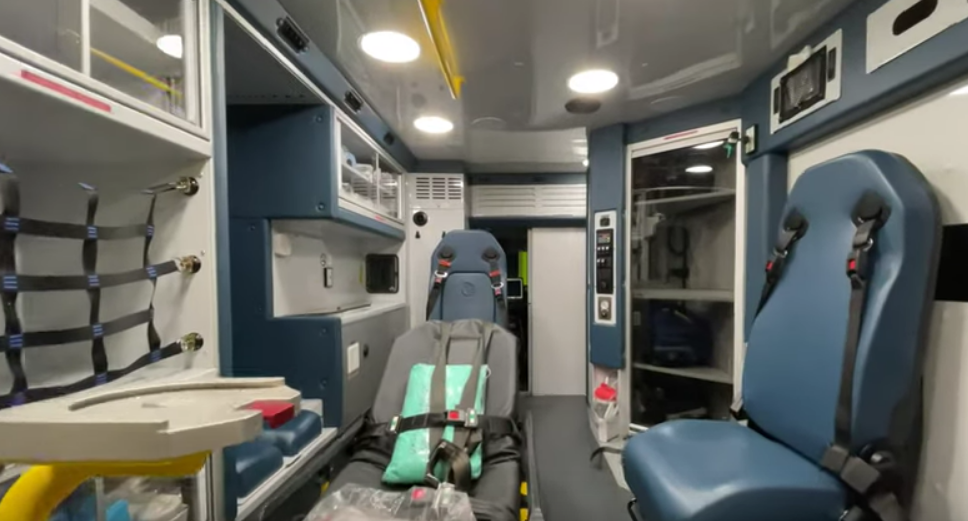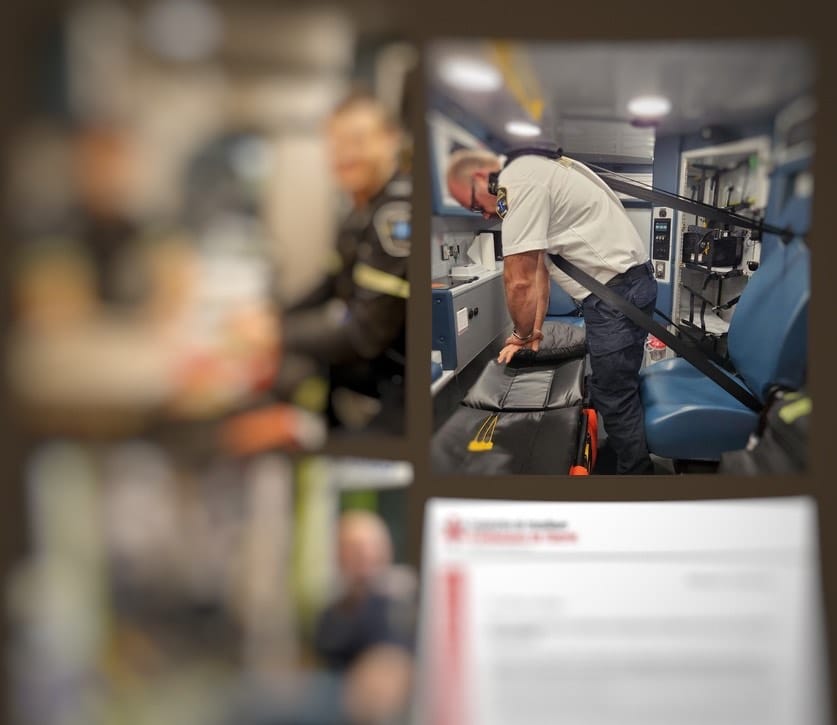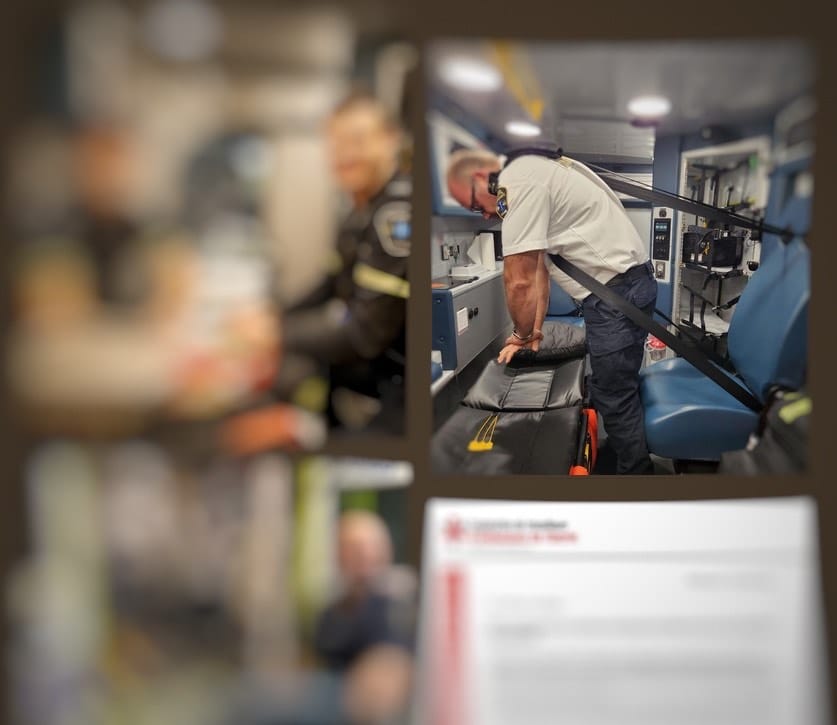Harnais de sécurité - avec des limites

English version follows the french.
Cette semaine, la Coopérative de Travailleurs d’Ambulance de l’Estrie (CTAE) a annoncé qu’elle avait modifié toutes ses ambulances pour remplacer les banquettes standards par deux sièges équipés de nouveaux harnais conçus pour la sécurité de leurs paramédics — ainsi que d’autres membres du personnel travaillant dans le compartiment des soins aux patients.
Il s’agit d’un investissement important pour la coopérative détenue par les employés. Chaque siège coûtait environ 2800 $, pour un montant total d’environ 55 000 $.
J’ai demandé à Keven Archambault, chef des communications de la CTAE, pourquoi il était important pour l’entreprise de prendre cette décision.
« Cette initiative vise à renforcer la sécurité de nos paramédics et à offrir une protection optimale lors de leurs interventions médicales d’urgences. La décision de passer des ceintures standards aux harnais dans nos ambulances témoigne de notre engagement envers la sécurité de nos équipes, tout en garantissant un niveau élevé de service à nos patients » a déclaré Archambault.
Tant la Coopérative des techniciens ambulanciers de la Montérégie (CETAM) qu’Urgences-santé ont également ces sièges installés dans certaines ou toutes leurs ambulances.
« Nous avons reçu nos premières ambulances avec ces sièges en 2023 et nous équipons toutes nos ambulances de ces sièges afin de maximiser la sécurité de nos membres, » a déclaré Patrick Jasmin, Coordinateur des communications et du marketing RH pour CETAM.
Une des photos dans la publication de la CTAE sur leur page Facebook a attiré mon attention.
Un paramédic debout tout en simulant une réanimation cardio-pulmonaire sur un patient.

J’ai vérifié avec Ambulance Demers, le fabricant d'ambulances, si ces sièges et harnais étaient conçus pour protéger le personnel debout effectuant la RCR dans une ambulance en mouvement.
Ce n’est pas le cas.
Renaud Carrier, directeur de l’ingénierie chez Ambulances Demers, a expliqué que bien que les sièges et harnais, fabriqués par EVS (basé dans l’Indiana), soient très efficaces pour maintenir un paramédic correctement attaché lorsqu’il est assis ou penché en avant pour soigner un patient sur une civière, « aucun système de siège et de harnais n’est conçu pour les protéger lorsqu’ils sont debout ».
Carrier a expliqué que les paramédics se plaignaient souvent du système de harnais standard à ceinture d’épaule car le point d’ancrage pour l’épaule signifiait que la ceinture était haute et attrapait souvent le paramédic juste sur le côté du cou.
Le nouveau système de harnais signifie qu’il peut être porté plus comme un sac à dos et une fois ajusté reste ajusté tout au long de la phase de transport de l’appel. Ainsi, si un paramédic se penche en avant, il n’a pas besoin de réajuster la retenue une fois qu’il se réinstalle dans le siège.
La violence des impacts à l’arrière d’une ambulance est bien illustrée dans cette vidéo de l’Institut national pour la sécurité et la santé au travail (NIOSH), une agence américaine qui mène des recherches et fait des recommandations pour la prévention des blessures et des maladies liées au travail.
Il ne fait aucun doute qu’être correctement attaché est essentiel pour les paramédics et autres membres du personnel d’urgence s’occupant du patient à l’arrière d’une ambulance en mouvement.
J'applaudis certainement la démarche du CTAE, du CETAM, d'Urgences-santé et d'autres entreprises d'ambulance pour améliorer la sécurité de leur personnel.
Cependant, il est important de réaliser que les nouveaux harnais présentent leurs propres limites.
Safety harnesses - with limits
This week, the Coopérative de Travailleurs d’ambulance de l’Estrie (CTAE) announced they had modified all of their ambulances to replace the standard bench seat to two seats equipped with new harnesses designed for the safety of their paramedics – and other personnel working in the patient care compartment.
It was an important investment for the employee-owned cooperative. Each seat cost about $2800 with the total amount coming in at approximately $55,000.
I asked Keven Archambault, Chief of Communications for CTAE, why it was important for the enterprise to take this decision.
“This initiative aims to enhance the safety of our paramedics and provide optimal protection during their emergency medical interventions. The decision to switch from standard seatbelts to harnesses in our ambulances reflects our commitment to the safety of our teams while ensuring a high level of service to our patients,” Archambault said.
Both the Coopérative des techniciens ambulanciers de la Montérégie (CETAM) and Urgences-santé have these seats installed in some or all of their ambulances.
“We received our first ambulances with these seats in 2023 and are equipping all our ambulances with these seats to maximize the safety of our members," said Patrick Jasmin, Coordinator of Communications and HR Marketing for CETAM.
One of the pictures in the CTAE post on their Facebook page caught my eye.
A paramedic standing up simulating performing CPR on a patient.

I checked with Demers Ambulances, the ambulance manufacturer, on whether these seats and harnesses were designed to protect personnel while standing and performing CPR.
They’re not.
Renaud Carrier, the Director of Engineering at Demers Ambulances, explained that while the seats and harnesses, which are manufactured by EVS (based in Indiana), are very effective in keeping a paramedic properly restrained while seated or leaning/scooting forward to care for a patient on a stretcher, “no seat and harness system is designed to protect them while they’re standing.”
Carrier explained that paramedics often complained about the standard shoulder-belt harness system because the anchor-point for the shoulder meant the belt was high and often caught the paramedic right across the side of the neck.
The new harness system means that it can be worn more like a backpack and once adjusted remains adjusted throughout the transport phase of the call. So, if a paramedic is leaning forward they don’t need to re-adjust the restraint once they settle back into the seat.
The violence of impacts in the back of an ambulance are well illustrated in this video from the National Institute for Occupational Safety and Health (NIOSH), an American agency which conducts research and makes recommendations for the prevention of work-related injury and illness.
There’s no doubt that being properly restrained is essential for paramedics and other emergency personnel caring for the patient in the back of a moving ambulance.
I certainly applaud the move by CTAE, CETAM, Urgences-santé and other ambulance enterprises to improve safety for their personnel.
However, it’s important to realize the new harnesses come with their own limitations.